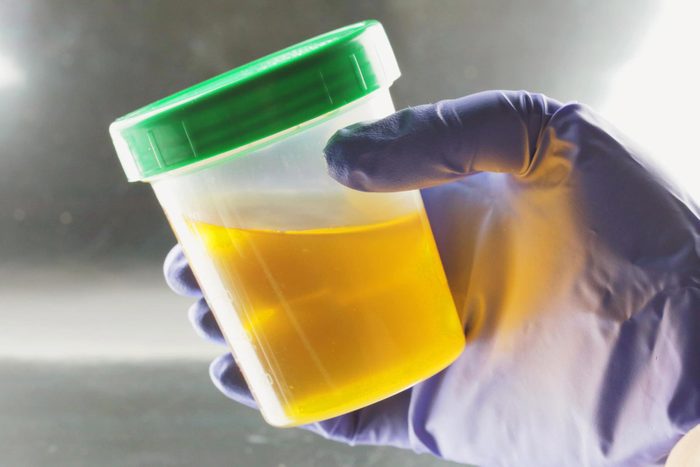Why Is Pee Yellow? Science Just Revealed the Answer
Updated: Apr. 11, 2024

We've got you covered next time you wonder about that golden hue when you go to the bathroom. And here's a spoiler: It's yet another fascinating aspect tied to our gut microbiome.
Have you ever found yourself musing over the body’s seemingly mundane quirks and curiosities during a quick trip to the loo? If so, you’re in good company. One of those age-old questions has puzzled not just the casually curious, but also the scientific community for well over a century: “Why is pee yellow?” Now, thanks to new research by a team from the University of Maryland (UMD) and the National Institutes of Health (NIH), we finally have an answer.
“It’s remarkable that an everyday biological phenomenon went unexplained for so long, and our team is excited to be able to explain it,” shares Brantley Hall, PhD, lead author of the study and an assistant professor at UMD in a university press release. The findings, published in the peer-reviewed scientific journal Nature Microbiology in January 2024, pinpoint a particular microbial enzyme found in our gut microbiome as the culprit behind pee’s yellow hue. This exciting discovery also adds to our gut microbiome’s significant influence on our overall health, opening new doors for medical research and understanding.
And if you’re thinking, “But my pee isn’t yellow,” don’t worry—we’ve got you covered with a comprehensive urine color chart, accompanied by expert advice, to guide you through what different urine colors may indicate about your health and what to do about it.
Why is pee yellow?
So, what exactly is a microbial enzyme, and how does it connect with the question of why is pee yellow? Simply put, these are proteins produced by microbes—tiny organisms like bacteria—that catalyze (or speed up) chemical reactions within our bodies. They’re essential for various bodily processes, from digestion to detoxification.
The science behind our pee’s color involves a series of such reactions. When red blood cells break down—a natural part of their lifecycle—they release bilirubin, a bright orange pigment. This bilirubin travels to the gut, where it’s usually excreted. However, some of it can get reabsorbed back into the bloodstream, leading to jaundice if accumulated in high amounts, characterized by a yellowing of the skin and eyes.
This is where our gut microbes come into play. They produce the newly discovered enzyme, bilirubin reductase, which transforms bilirubin into urobilinogen, a colorless byproduct. Urobilinogen then breaks down into urobilin, the molecule directly responsible for urine’s yellow color. The study authors clarify that while the presence of urobilin as the pigment of pee has been known for over a century, the precise pathway of its creation has remained hidden until now.
6 Things That Can Cause Bright Yellow or Green Pee, from Urologists
Health implications and future research
The study authors explain that the presence of bilirubin reductase in almost all healthy adults—and its absence in newborns and individuals with specific health conditions like inflammatory bowel disease (IBD)—suggests its significant role in our overall health. This absence could contribute to conditions like infant jaundice and the development of pigmented gallstones, indicating that understanding this enzyme’s function could lead to new treatments and preventive measures.
“Now that we’ve identified this enzyme, we can start investigating how the bacteria in our gut impact circulating bilirubin levels and related health conditions like jaundice,” noted study co-author and NIH Investigator Xiaofang Jiang, PhD. Future research will likely explore how gut microbial bilirubin metabolism influences our health, from neonatal jaundice and IBD to its relationship with obesity, insulin resistance, and cardiovascular disease, as these conditions have all shown a link with bilirubin concentrations.
For more wellness updates, subscribe to The Healthy @Reader’s Digest newsletter and follow The Healthy on Facebook and Instagram. Keep reading:




















